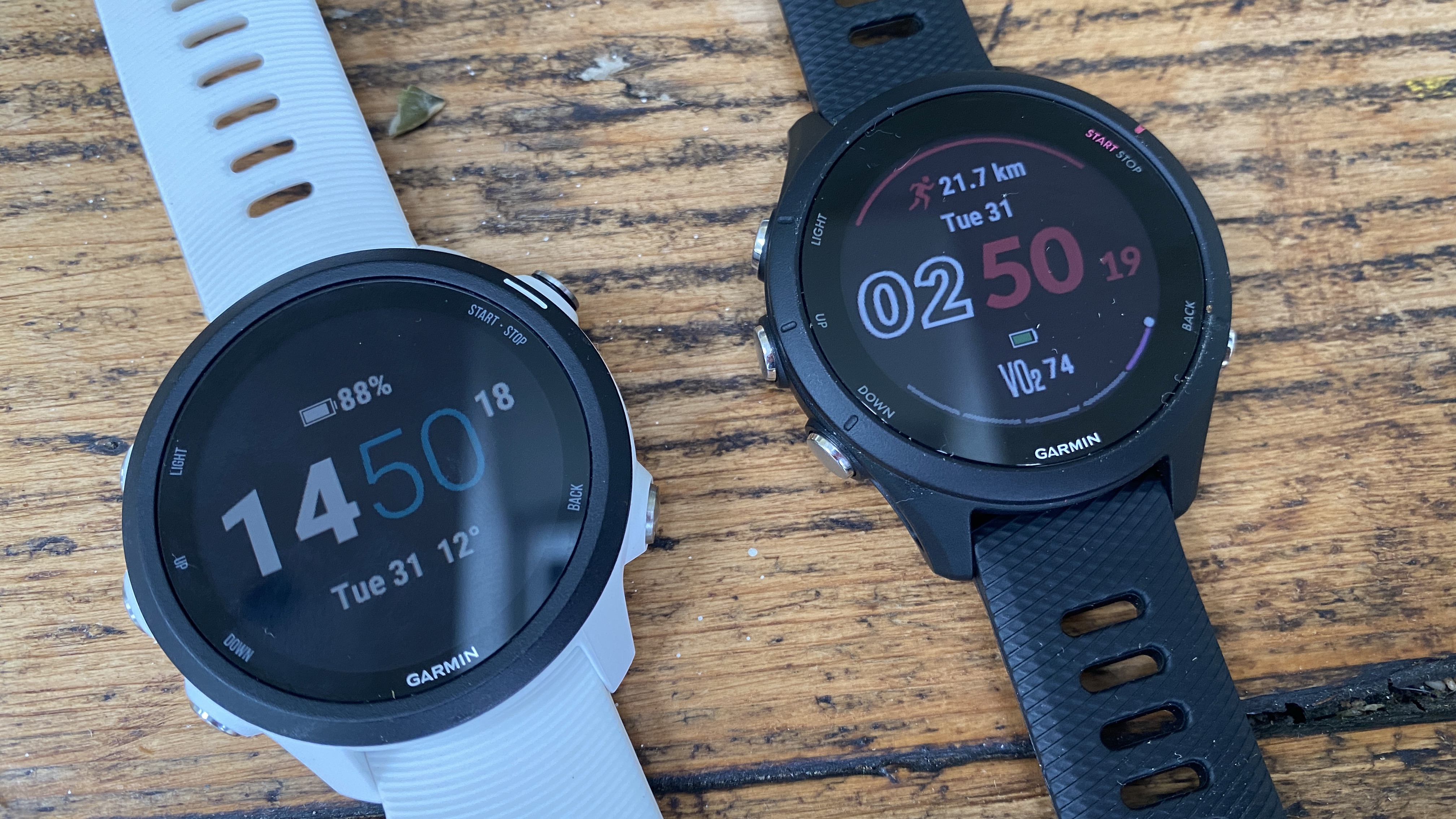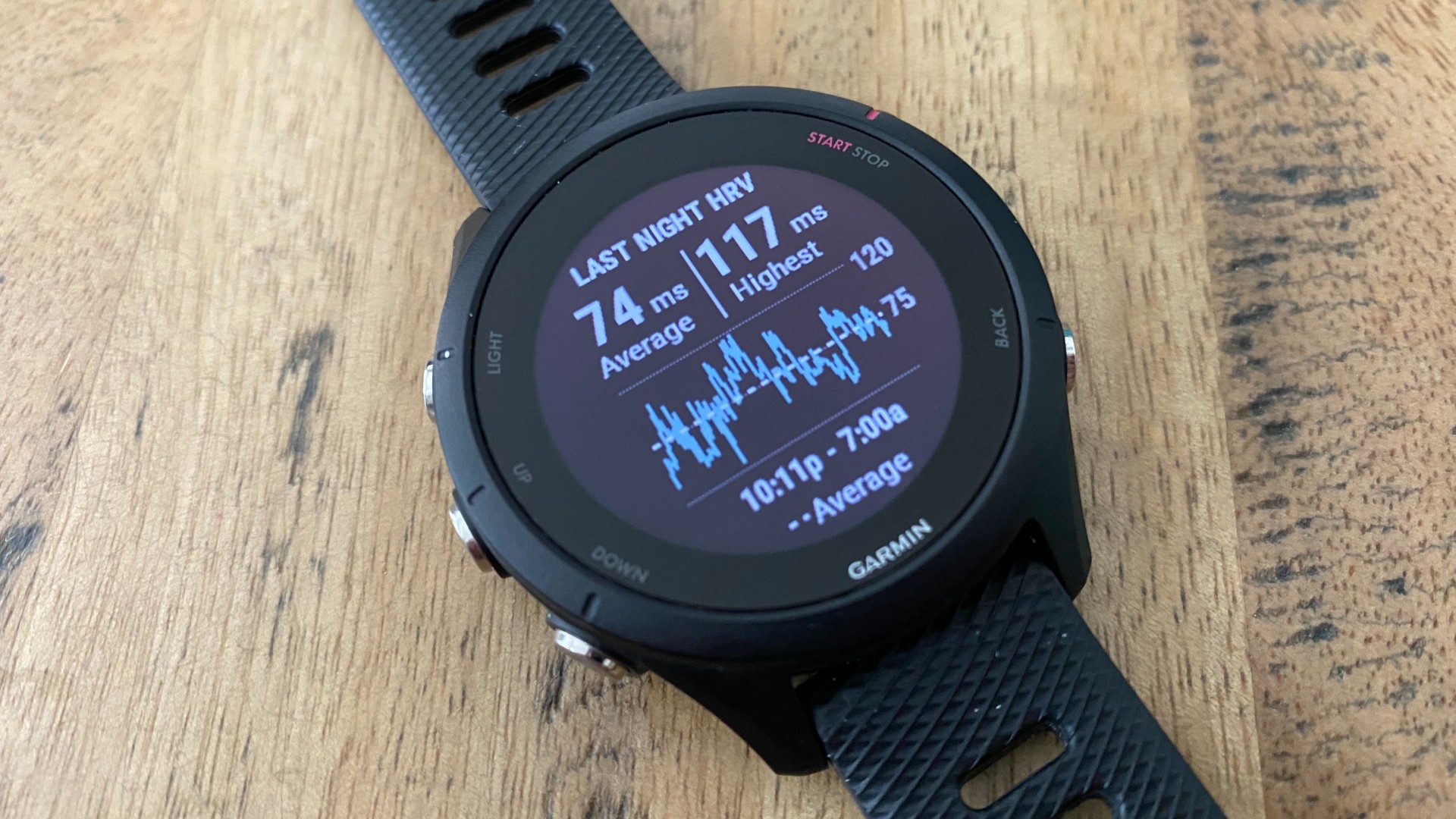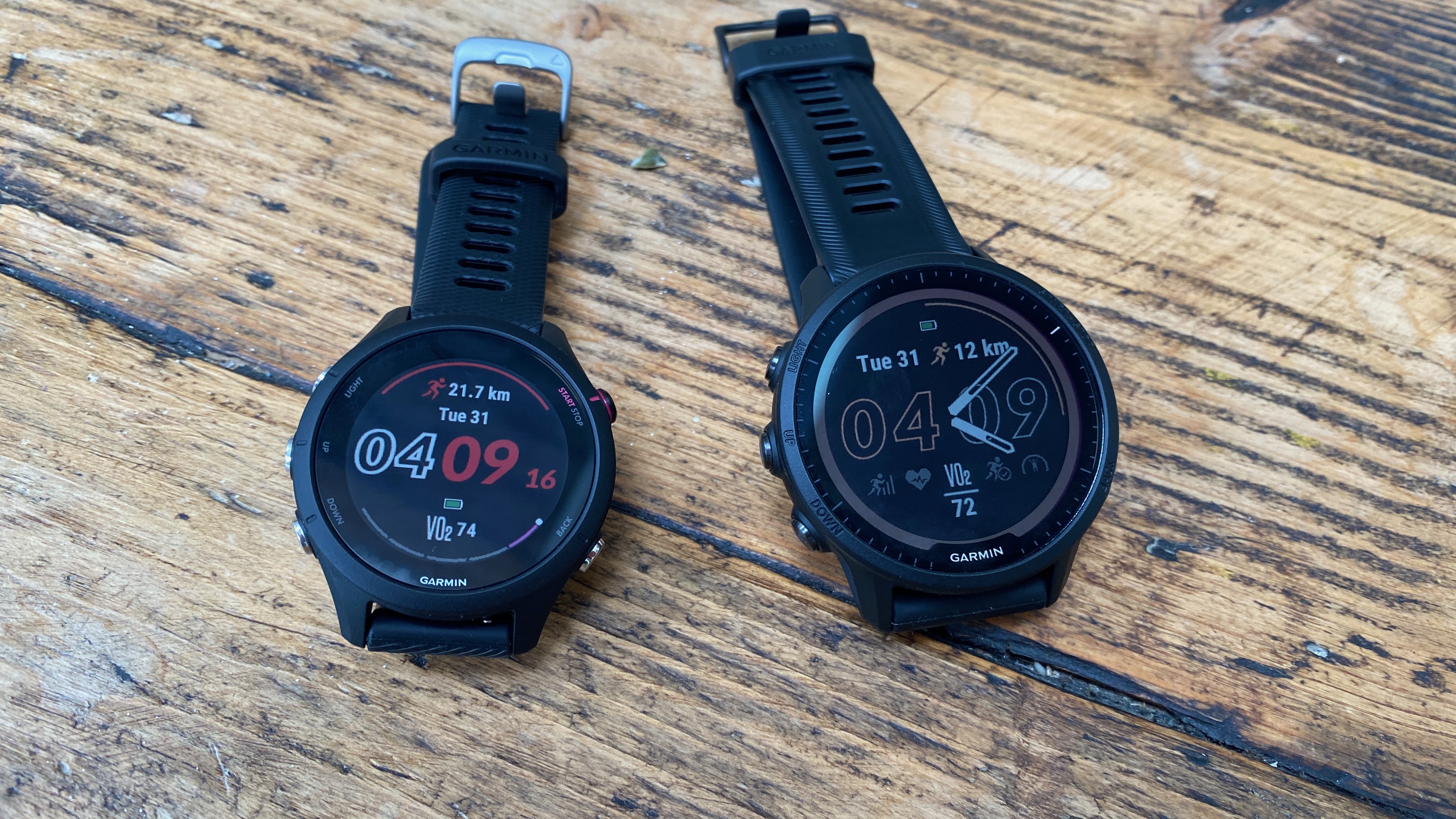Our Verdict
The Garmin Forerunner 255 is an improvement on the excellent Forerunner 245 and is a great new option for triathletes. However, runners might still find better value in the older watch since Garmin has increased the RRP of the 255 range by $50/£50.
For
- Superb sports tracking
- New size options
- Lightweight design
Against
- Price rise
- Didn’t get Garmin’s new training readiness feature
- Battery life is just OK
You can trust Coach
The Garmin Forerunner 245 has been a fixture in our best running watches round-up since it was launched, offering all of the key features runners at any level needed to track and analyse their training.
Garmin is now targeting triathletes as well as runners with the next-generation Forerunner 255, which is the first in the “2X5” line to include a multisport mode. That’s just one of a host of updates to the watch, which I have been testing for a month to see if it remains one of the best fitness trackers going.
- NEWSFLASH: The Garmin Enduro 2 is Garmin’s new top sports watch
Garmin Forerunner 255: Price And Availability
The Forerunner 255 is available now from Garmin US and Garmin UK, and comes in two sizes: the standard 255 which has a 46mm case and the 255S which has a 41mm case. There are two versions of each size – the 255 Music and 255S Music both offer music and cost $399.99 in the US and £349.99 in the UK, while the base 255 and 255S models don’t have music and cost $349.99/£299.99. That’s a significant price rise from the Garmin Forerunner 245, which now costs $224.99/£209.99 for the base model and $349.99/£299.99 for the 245 Music.
December 1, 2023: There are now regular sales and deals featuring the Garmin Forerunner 255. In our extensive coverage of the best Black Friday Garmin deals in 2023 the best price we tracked was $299.99. Our deal tracking of Amazon Prime Day Garmin deals in 2023 revealed a best price of £216.65.

Design And Hardware Specs
The Forerunner 245 had a 42.3mm case, so the 41mm Forerunner 255S is slightly smaller, while at 46mm the Forerunner 255 is a fair bit larger. The 255 has a 33mm 260x260 pixel screen, while the 255S’s is 27.9mm and 218x218 pixel. The Forerunner 245 has a 30.4mm 240x240 pixel display.

I have been testing the smaller Forerunner 255S, which really is delightfully dainty. I would prefer the bigger screen of the 255, but having two size options is great, especially since the larger 255 is still a small and light watch. Even when using the 255S with five stats on the screen it has been clear enough to read during runs easily. The smaller size results in a lesser battery, but otherwise the two sizes have an identical set of features.
The Forerunner 255 is the cheapest watch in Garmin’s range to offer multi-band GPS, which was introduced on the Garmin Epix 2 and Garmin Fenix 7 earlier this year. The 255 also offers a multi-GNSS all-systems-on mode which uses GPS, GLONASS and Galileo satellites simultaneously. In my long-term testing of the very expensive Epix 2 I have seen an improvement in the GPS accuracy of the watch compared with other devices, so it’s good to see this rolled out to a mid-range device.
Unlike the Forerunner 245, the new watches have a barometric altimeter, which makes for more accurate elevation tracking while exercising and adds a floors climbed section to the everyday activity stats.
Sign up for workout ideas, training advice, reviews of the latest gear and more.
The watch also has Garmin’s Elevate V4 optical heart rate sensor, a pulse oximeter to measure blood oxygen saturation, and a compass, and it is waterproof to 5 ATM.

GPS And Heart Rate Accuracy
As mentioned, I have enjoyed the improved GPS accuracy of the Garmin Epix 2, and I’ve also noticed the same benefits when using the multi-band mode on the Garmin Forerunner 955 and Fenix 7 watches. However, multi-band is not always an immediate upgrade – on Huawei’s devices with multi-band GPS the accuracy has been poor, and it was good, but not exceptional on the Coros Vertix 2.
I say this because the Forerunner 255’s tracking has not been as good as the Epix 2 or 955 during my testing. I have done almost all of my runs with it while also wearing the 955, and while the 255 has generally been very good, on faster runs, especially on looped routes, it tended to overestimate my pace and distance.
I can see on the GPS track that the added distance comes from the track swerving to the wrong side of the road or overshooting corners, a problem which is exacerbated on looped courses. While it still produced more accurate results than the Forerunner 245 in side-by-side testing, and this could be a problem with just the device I’m testing, my sample has not been as good as other Garmins in multi-band mode.
On the other hand the heart rate accuracy has been excellent. I’ve tested it against a chest strap on almost every run and can’t remember an instance where the 255’s optical heart rate reading was significantly off. I’m a stickler for using a chest strap in order to get accurate data into the training analysis on watches, but you could take the risk and not use one with the 255 – it’s been that good for me.
Sports Tracking
The big news in this area is that the Forerunner 255 now offers a multisport mode, making it the cheapest option in Garmin’s range for triathletes. The Forerunner 255 also offers sports modes for pretty much every other activity you can think of, and the depth of data available is particularly impressive for running, cycling and swimming.
Detailed tracking is just the start of what the 255 offers athletes, though, with upgraded training analysis and suggested workouts introduced in this generation. It does not get the new training readiness feature which debuted on the Forerunner 955, but it still offers a lot of data to help you keep your training on track.
Acute load tracking, which looks at the intensity of recent workouts to see if the load is appropriate for you, is a new addition. You also get an indication of what your training focus has been – easy, tempo or anaerobic. That’s something that has been available on Garmin’s more expensive watches for a while, but isn’t on the Forerunner 245.

Some of that training analysis also feeds into the new race widget. Once you set up a race in the Garmin Connect app or website, the watch will display weather forecasts for the event and a predicted time. Your suggested workouts will also adjust in line with the race you have planned.
The Forerunner 255 also offers Garmin’s morning report feature, which provides information like your sleep rating and weather forecast, along with your suggested workout for the day and your heart rate variability (HRV) status. The latter is also a new feature on the watch and the info it provides can be used to judge what kind of training you do that day because it shows how recovered your body is.

It takes three weeks for the HRV status to start showing up, since the watch needs to establish your baselines to see if you fall within a normal range on a given day. If so, your HRV status will show as balanced, or if it’s unbalanced the watch will suggest you reduce the intensity of your training. I compared the HRV readings from the 255S with the Oura ring and the 955 throughout my testing, and while the 255 often missed spikes in my HRV overnight, it generally recorded a similar average to the Oura ring, which I rate as a highly accurate device.

Along with the daily suggested workouts you can set up training plans for 5K, 10K and half marathon events to follow on the watch, and the training status information it provides will tell you if your training is productive.
If you use a Garmin Running Dynamics Pod or HRM-Pro you will be able to see your running power on the Forerunner 255 live during your runs without using an app.
Battery Life
The larger 255 offers more battery life, lasting up to 14 days in smartwatch mode and 30 hours with GPS-only sports tracking (using multi-band GPS or listening to music will reduce this). In comparison the Forerunner 255S lasts up to 12 days in smartwatch mode and 26 hours in GPS-only tracking mode.
As such both are an improvement on the Forerunner 245, which lasts up to seven days in smartwatch mode and offers 24 hours of GPS tracking. However, if you use the multi-band GPS tracking and log outdoor activities regularly the numbers come down sharply.
I found that I would get less than a week from the Forerunner 255S running every day in multi-band mode, which is not bad given the features it offers and the small case size, but you can get far more battery life from the similarly small Coros Pace 2.

Activity And Sleep Tracking
The Forerunner 255 is designed to be worn outside of your training as well, and it tracks all the usual stats like steps, calories burned and floors climbed. It also tracks your blood oxygen saturation and has Garmin’s body battery feature, which gives a snapshot rating of your energy levels out of 100 throughout the day. The Forerunner 255 also supports Garmin’s features for women, including pregnancy and menstrual cycle tracking. This information feeds into the new race widget so training can be adjusted around your menstrual cycle.
With sleep tracking, the 255 struggled in the same way all Garmin watches I’ve tested struggle, in that it overestimated time asleep by logging periods where I was still but awake (so reading or watching TV) as light sleep. There is an update coming that will hopefully improve Garmin’s sleep tracking across its range, but I’ve found that its watches do consistently underperform in this area compared with devices from Polar, Huawei and Fitbit in particular.
Smart Features
The more expensive 255 Music and 255S Music watches offer music storage and the ability to link a Spotify Premium account to store your playlists on the watch offline. The music features on Garmins are uniquely strong compared with other sports watches – it’s really only true smartwatches that rival them in how easy it is to get music on and connect Bluetooth headphones.
All the watches in the range can complete NFC payments using Garmin Pay. There are also weather forecasts and you can download apps from the Connect IQ store. There aren’t many apps in there at all, but there are hundreds of watch faces you can use if you don’t love the default options on the watch.
Navigation
The Forerunner 255 offers breadcrumb navigation with turn-by-turn directions, and you can sync routes created in third-party apps such as Strava and Komoot, as well as making them in Garmin Connect. You can also bring up a pointer to guide you back to your starting point during activities. Following the routes using these breadcrumb trails isn’t as easy as using the colour maps on Garmin’s most expensive watches, but I found the courses were still clear enough to be usable, even on the smaller 255S screen.
Is The Garmin Forerunner 255 Worth It?

The updates to the Forerunner 255 and 255S are useful and if you’re a very keen runner like me, I would pay extra for them rather than settle for the Forerunner 245. The improvements in GPS accuracy in particular would sway me, even if the accuracy was not quite as good as on the more expensive Garmins with multi-band tracking.
However, I am probably in the minority, and my hunch is that most runners will still be more than satisfied with the features and accuracy of the Forerunner 245 and 245 Music – and getting the basic 245 for $225/£210 is a significant saving.
That’s runners, though. Triathletes will naturally be delighted by the new sports modes on the Forerunner 255, and this is a very impressive all-round multisport watch for its price. Having two size options is useful, and other features like Garmin Pay, running power and the increased training analysis might persuade some people to choose the 255 over the 245 as well.
The competition from outside Garmin comes from the Coros Pace 2, a full multisport watch with great battery life that costs $199/£179.99, and the Polar Pacer Pro, another good multisport watch that costs $299/£259. Both are significantly cheaper than the Forerunner 255, even if I rate the 255 the best watch of the three.
If you’re just looking for the essentials done well, the Pace 2 is your best bet at $150/£120 less than the cheaper Forerunner 255, even though the Coros doesn’t have breadcrumb navigation. The Polar Pacer Pro does have navigation, but I find Polar’s user interface less easy to navigate than Garmin’s, and the Pacer Pro doesn’t have multi-band tracking or music.

Nick Harris-Fry is a journalist who has been covering health and fitness since 2015. Nick is an avid runner, covering 70-110km a week, which gives him ample opportunity to test a wide range of running shoes and running gear. He is also the chief tester for fitness trackers and running watches, treadmills and exercise bikes, and workout headphones.

